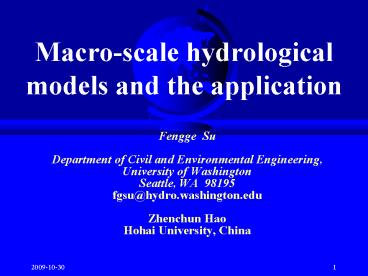Macroscale hydrological models and the application - PowerPoint PPT Presentation
1 / 30
Title:
Macroscale hydrological models and the application
Description:
Runoff improvement in the land surface model AVIM (Atmosphere Vegetation ... under the assumption of neglecting horizontal heterogeneities, the runoff will ... – PowerPoint PPT presentation
Number of Views:97
Avg rating:3.0/5.0
Title: Macroscale hydrological models and the application
1
Macro-scale hydrological models and the
application
- Fengge Su
- Department of Civil and Environmental
Engineering, - University of Washington
- Seattle, WA 98195
- fgsu_at_hydro.washington.edu
- Zhenchun Hao
- Hohai University, China
2
Contents
- Macro-scale hydrological model
- Runoff improvement in the land surface model AVIM
(Atmosphere Vegetation Interaction Model) - Streamflow simulations for major river basins in
China by the use of VIC model
3
1. Macro-scale Hydrological Model
- the Xinanjiang Model is used as the basic model
to develop a grid-based distributed hydrological
model. - The Huaihe River Basin with the area of 270,000
km2 is selected as the research area. A 30km30km
squared-grid is adopted There are totally 307
grid cells.
4
Huaihe River Basin with 270,000km2 of the area
5
17 sub-areas with 307 grid cells
? ?
??
??
??
????
???
??
???
??
??
??
???
??
???
??
??
???
6
(No Transcript)
7
(No Transcript)
8
(No Transcript)
9
2. Improvement of runoff parameterization in AVIM
- Brief description to the land surface scheme
AVIM(Atmosphere-Vegetation Interaction model) - Improvement of runoff parameterization in AVIM
- Hydrological simulations over Xilinhe drainage
basin
10
- Runoff plays an important role in land surface
water budgets. - The treatment of hydrological processes in AVIM
is too rough, and runoff is simply an excess of
precipitation over evapotranspiration. - The purpose of this study is to improve the
parameterization of runoff generation in AVIM.
11
Brief description to AVIM
- Canopy in AVIM is considered as a uniform
- layer covering the soil with a shielding
factor. - The soil column is divided into three layers
- upper layer(d10.1m) lower layer(d20.9m)
- deep layer(d3d2).
12
Evapotranspiration in land surface scheme AVIM
Wet canopy evaporation
Evapotranspiration
Dry canopy transpiration
Bare soil surface evaporation
13
The soil model
- Diffusion type multi-layer scheme
14
Runoff
The parameterization of runoff in AVIM is
very simple. It is assumed that the rainfall Pg
infiltrates the upper layer of soil. As soil gets
saturated, the surface runoff (rof) will occur
and is equal to the excess of rainfall over
evaporation.
15
The treatment of the heterogeneity in the
Xinanjiang model
16
Improvement of runoff parameterization in AVIM
Rof
17
Runoff generation model
18
- The calculation of runoff may then be expressed
in the form - Then W0 and WM can be expressed as
19
Hydrological simulations over Xilinhe drainage
basin
- Basin description
- Data
- Experimental design
20
Basin description
- The Xilinhe drainage basin is located in the east
of Inner Mongolia plateau of China, and belongs
to arid and semi-arid climate. - Mean annual precipitation is about 350mm mean
annual runoff depth is only5.7mm runoff
coefficient is 0.016. - Most of the runoff is generated in spring by
snowmelt, and 66.5 of the runoff occurs in Apr.
and May.
21
Data
- The hydrological simulations area is upstream of
Xilinhaote station, which is located at 11610'E
, 4849'N, with the drainage area of 3852 square
kilometers. - The data for calibration and validation comprises
daily streamflow from Xilinhaote gauging station
and daily atmospheric forcing data from the year
1991 to 1994, including observed radiation,
precipitation, air temperature, humidity, wind,
and cloud cover. - The improved AVIM model is run at an hourly time
step.
22
Experimental design
- Model is run in the three situations
- Running the original version of the AVIM model
- Running the improved AVIM model, using the
energy-balance snow model - Running the improved AVIM model, using a
degree-day snow accumulation and ablation model.
23
- The original AVIM model results indicate that
all the calculated runoff is zero. That is
because, under the assumption of neglecting
horizontal heterogeneities, the runoff will not
occur until the entire upper layer is saturated,
but the saturation is rarely reached in Xilinhe
basin with the even precipitation of 350mm/y.
24
Daily observed and simulated streamflow at
gauging station Xilinhaote for the period
1991-1994 (by the improved AVIM model with the
energy-balance snow model)
25
Daily observed and simulated streamflow at
gauging station Xilinhaote for the period
1991-1994 (by the improved AVIM model with the
day-degree snow model)
26
- The Xilinhe drainage basin is located in arid and
semi-arid zone. Annual runoff depth is only
5.7mm,and runoff coefficient is about 0.016. It
is a challenge to select the basin to simulate
the hydrologic processes. - The simulated rainfall-runoff processes are
acceptable and encouraging. It indicates that the
modification of runoff generation scheme in AVIM
is reasonable and effective.
27
The difference of calculated upper soil water
content(mm) between the original AVIM (no runoff)
and the improved AVIM model (having runoff)
28
The difference of calculated latent heat(w/m2)
between the original AVIM (no runoff) and the
improved AVIM model (having runoff)
29
The difference of calculated sensible heat(w/m2)
between the original AVIM (no runoff) and the
improved AVIM model (having runoff)
30
Conclusion and discussion
- The runoff generation scheme in the original AVIM
was improved. - The model was used to simulate daily hydrographs
for the Xilinhe drainage basin, and there was an
acceptable agreement between the observed and
simulated streamflow in rainfall-runoff processes
at the Xilinhaote station. - Though, streamflow simulation is not the main
task in land surface scheme, it can act as a
diagnostic tool for verification of water balance
model in the scheme.































